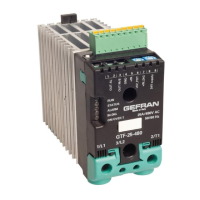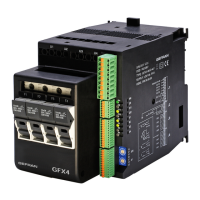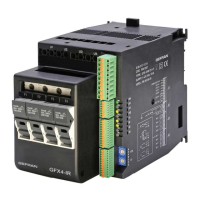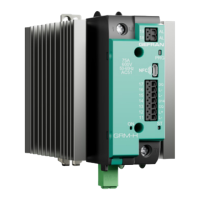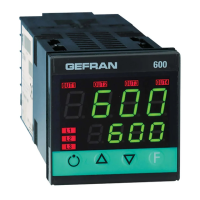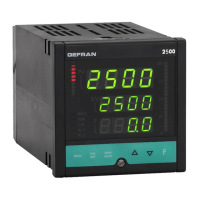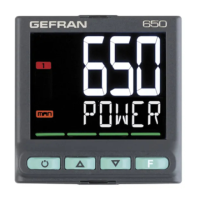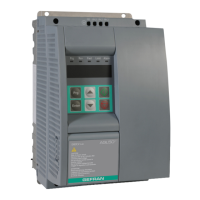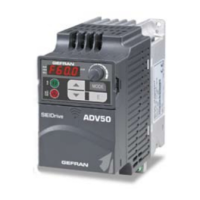14
80961F_MSW_GTF/GTF-Xtra_07-2018_ENG
ALARMS
HB ALARM (Heater Break Alarm)
This type of alarm identifies load break or interruption by measuring the current delivered by means of a current
transformer.
The following three fault situations may occur:
- delivered current is lower than nominal current: this is the most common situation, and indicates that a load
element is breaking.
- delivered current is higher than nominal current: this situation occurs, for example, due to partial short circuits of
load elements.
- delivered current remains significant even during periods in which it should be zero: this situation occurs in the
presence of pilot circuits for the short-circuited load or due to relay contacts soldered together. In these cases, prompt action
is very important to prevent greater damage to the load and/or to the pilot circuits.
In standard configuration, output SSR is associated to heating control in zone 1, obtained by modulating electrical
power with the ON/OFF control based on the set cycle time.
The current read performed during the ON phase identifies an anomalous shift from the rated value due to a load break (first
two fault situations described above), while the current read performed during the OFF phase identifies a break in the control
relay, with consequent output always active (third fault situation).
The alarm is enabled by means of parameter Hd.2; select the type of function you want by means of parameter Hb.F:
Hb.F=0: alarm activates if the current load value is below the setpoint value set in A.Hbx while the SSR control output is ON.
Hb.F=1: alarm activates if the current load value is above the setpoint value set in A.Hbx while the SSR control output is OFF.
Hb.F=2: alarm activates by combining functions 0 and 1, considering the setpoint of function 1 as 12% of the ammeter full
scale defined in H.tAx.
Hb.F=3 or Hb.F=7 (continuous alarm): alarm activates due to a load current value below the setpoint value set in A.Hbx; this
alarm does not refer to the cycle time and is disabled if the heating (cooling) output value is below 3%.
Setting A.Hbx = 0 disables both types of HB alarm by forcing deactivation of the alarm state.
The alarm resets automatically if its cause is eliminated.
An additional configuration parameter for each zone, related to the HB alarm is:
Hb.t = delay time for activation of HB alarm, understood as the sum of times for which the alarm is considered active.
For example, with:
- Hb.F = 0 (alarm active with current below setpoint value),
- Hb.t = 60 sec and cycle time of control output = 10 sec,
- power delivered at 60%,
the alarm will activate after 100 sec (output ON for 6 sec each cycle);
if power is delivered at 100%, the alarm will activate after 60 sec.
If the alarm deactivates during this interval, the time sum is reset.
The delay time set in Hb.t must exceed the cycle time of the SSR output.
For loads such as IR lamps, with high temperature coefcient, the HB alarm is disabled when delivered power is below 20%.
Function: HB alarm setpoint self-learning
Function: HB alarm setpoint self-learning
This function permits self-learning of the alarm setpoint.
To use this function, you first have to set parameter Hb.P, which defines the percentage of current compared to rated load
below which the alarm trips.
The function can be activated via control from serial line or digital input (see parameter dIG or dIG.2) or key (see HW/SW
Information-Key Features).
When the Teach-in function is activated in modes ZC, BF and HSC, the RMS current value in conduction ON multiplied by
parameter Hb.P determines the HB alarm setpoint.
When the Teach-in function is activated in mode PA NO infrared lamps, the existing RMS current value is shown at 100% of
power, which, multiplied by parameter Hb.P, determines the HB alarm setpoint. Before activating the function, it is necessary
that the GTF is switched on with power, it is recommended, above 50%.
In the case of HSC mode or PA for infrared lamps (see parameter Hd.5 option +128), the function activates automatic
reading of the power/current curve useful for determining the HB alarm setpoint.
Automatic reading of the power/current curve takes place with the following sequence:
- softstart at maximum power (default 100%), 5 sec. delay
- reduction of power to 50%, 30%, 20%, 15%, 10%, 5%, 3%, 2%, 1% between every value 5 sec. delay
- return to normal operation.
In this phase, the maximum conduction value can be limited by means of parameter Hb. Pm
In case of HSC firng mode, the Heater Break alarm teach-in function doesn’t calibrate at 5%, 3%, 2% and 1% in order to avoid
high peak currents due to the low impedence at very low temperature of the IR lamp filament.
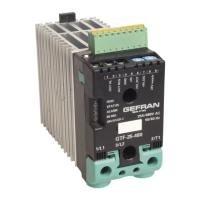
